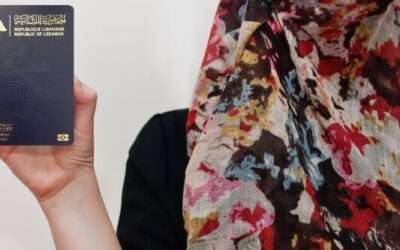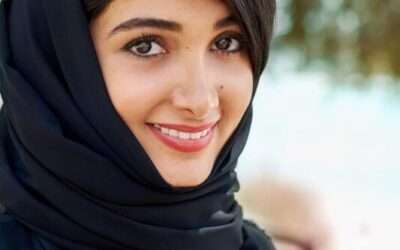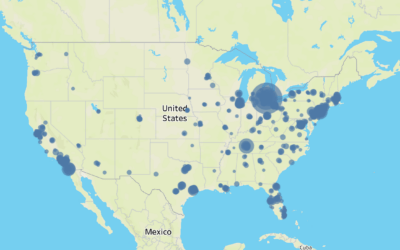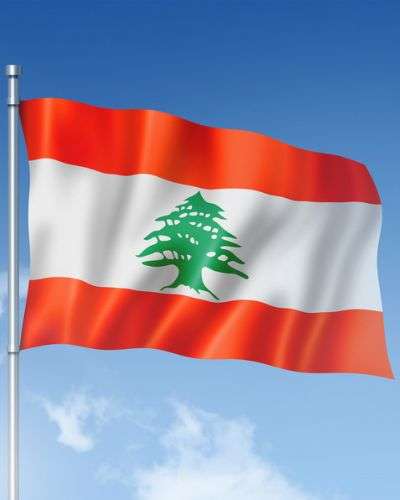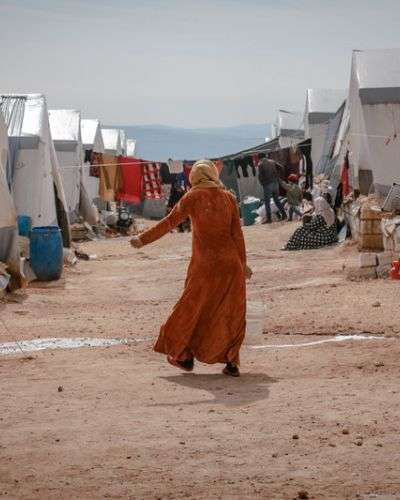Lebanese Arabs in North America
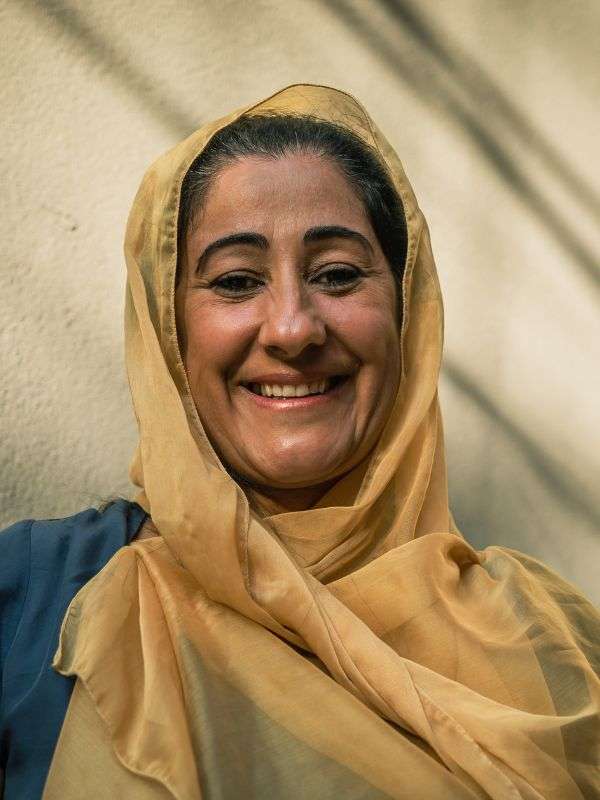
The first Lebanese immigrants to North America arrived at the end of the 19th century from the Ottoman Province of Syria, which comprised modern-day Syria, Lebanon, Palestine, and Israel. Many of the first immigrants settled in Boston and New York and became peddlers of housewares, clothing, and hardware. During this time of migration, most Lebanese moving to Canada settled in Montreal. Over time, many moved west to cities like Detroit and Cleveland to work in factories. Others bought farms in Iowa, the Dakotas, and Texas.
A second wave of immigration occurred during the Lebanese Civil War between 1948-1990. In this wave, many Lebanese Muslims and Druze migrated and settled in cities throughout North America. It is estimated that 344,000 Lebanese Muslims live in North America. Today, North America’s largest Lebanese Muslim communities are in Detroit, Boston, New York, Los Angeles, Montreal, and Toronto.
In Lebanese culture, age is respected, and allegiance to family is valued above all else. While this remains true for Lebanese in the diaspora, the culture has changed since families don’t typically live in multi-generation homes. The elaborate and overwhelming hospitality of Lebanese in the diaspora continues. When visiting a Lebanese home, one can expect a warm welcome, food, and drink.
Religious Life
Lebanon is one of the most religiously diverse countries in the Arab world, with approximately 65 percent Muslim, 32 percent Christian, and about 3 percent Druze with small numbers of Jews and other faiths. Maronite Catholics make up the majority of Christians, while the Muslim population divides nearly equally between Sunni and Shi’a followers.
While most of the first Lebanese immigrants to North America were Maronite Christians, the Muslim population was large enough to establish mosques in Maine, North Dakota, and Michigan. The oldest purpose-built mosque still in use is in Cedar Rapids, Iowa, which Syrian-Lebanese Muslims built in 1934.
Among the Lebanese Muslim communities, there are Shi’a and Sunni populations, with both groups remaining unreached in North America. The Islamic Center of America, located in Dearborn, MI, is the largest Shi’a mosque in the US. A group of young Lebanese Americans founded it in the 1950s. The Lebanese Islamic Center in Montreal, founded in the 1970s, is also a Shi’a mosque.
The Druze, a small minority in Lebanon, share beliefs with Islam, Christianity, and other religions. They form tight-knit communities where they live and rarely marry outside of their faith. There are approximately 75,000 in North America, with the largest unreached population living in California.
These are the Lebanese Muslim communities in North America most in need of gospel witness
| People Group | Metropolitan Area | Population Size | Concentrated Area | Priority Score |
|---|---|---|---|---|
| Afghan | Houston | 9,850 | Gulfton | 48 |
| Afghan | Los Angeles | 16,719 | Irvine | 57 |
| Afghan | Montreal | 10,805 | Saint-Martin (Laval) | 59 |
| Afghan | New York | 9,871 | Flushing (Queens) | 49 |
| Afghan | Sacramento | 21,673 | Elk Grove | 69 |
| Afghan | San Diego | 7,189 | El Cajon | 58 |
| Afghan | San Francisco | 32,142 | Fremont | 69 |
| Afghan | Seattle | 6,994 | Kent | 54 |
| Afghan | Toronto | 43,075 | Scarborough | 57 |
| Afghan | Vancouver | 7,980 | New Westminster | 51 |
| Afghan | Washington D.C. | 33,236 | Springfield | 73 |
| Afghan Hindu/Sikh | New York | 6,000 | Hicksville (Long Island) | 86 |
| Albanian Muslim | Boston | 15,903 | Revere | 53 |
| Albanian Muslim | Chicago | 11,230 | Berkeley/Elmhurst | 49 |
| Albanian Muslim | Detroit | 19,949 | Sterling Heights | 55 |
| Albanian Muslim | New York | 48,123 | Pelham Parkway (Bronx) | 65 |
| Albanian Muslim | Philadelphia | 6,857 | Northeast | 35 |
| Algerian Arab | Montreal | 59,585 | Little Maghreb | 71 |
| Bambara | New York | 5,000 | Harlem | 69 |
| Bangladeshi | Atlanta | 5,839 | Doraville | 46 |
| Bangladeshi | Dallas Fort Worth | 6,355 | Irving | 47 |
| Bangladeshi | Detroit | 11,087 | Hamtramck | 44 |
| Bangladeshi | Los Angeles | 7,362 | Little Bangladesh | 46 |
| Bangladeshi | Montreal | 10,675 | Parc Extension | 48 |
| Bangladeshi | New York | 84,099 | Jamaica (Queens) | 41 |
| Bangladeshi | Philadelphia | 7,295 | Hatfield | 47 |
| Bangladeshi | Toronto | 36,670 | Danforth Village | 47 |
| Bangladeshi | Washington D.C. | 11,798 | York Town (Arlington) | 48 |
| Belzer Jewish | New York | 12,518 | 86 | |
| Bobover Jewish | New York | 23,509 | 90 | |
| Bosniak | Atlanta | 12,000 | Lawrenceville | 61 |
| Bosniak | Boston | 8,000 | Revere | 59 |
| Bosniak | Bowling Green | 5,000 | Morgantown Road | 60 |
| Bosniak | Chicago | 60,000 | Northside | 81 |
| Bosniak | Des Moines | 10,000 | Merle Hay | 63 |
| Bosniak | Detroit | 10,000 | Hamtramck | 64 |
| Bosniak | Grand Rapids | 10,000 | Kentwood | 63 |
| Bosniak | Jacksonville | 11,000 | Hogan | 65 |
| Bosniak | New York | 12,000 | Astoria (Queens) | 63 |
| Bosniak | Phoenix | 10,000 | Glendale | 64 |
| Bosniak | Seattle | 6,000 | Shoreline | 60 |
| Bosniak | St. Louis | 70,000 | Mehlville | 79 |
| Bosniak | Toronto | 7,120 | Etobicoke | 61 |
| Bosniak | Utica | 5,000 | Bleecker St. | 60 |
| Breslov Jewish | New York | 5,000 | 86 | |
| Bukharan Jewish | New York | 60,000 | 74 | |
| Chabad Lubavitch Jewish | New York | 27,103 | 91 | |
| Egyptian Arab | Boston | 5,359 | Dudley Square | 23 |
| Egyptian Arab | Chicago | 5,784 | Hickory Hills | 23 |
| Egyptian Arab | Dallas Fort Worth | 5,136 | Richardson | 33 |
| Egyptian Arab | Houston | 5,992 | Katy | 32 |
| Egyptian Arab | Los Angeles | 23,765 | Anaheim | 40 |
| Egyptian Arab | Montreal | 9,167 | Saint-Laurent | 27 |
| Egyptian Arab | New York | 56,257 | Astoria (Queens) | 46 |
| Egyptian Arab | Philadelphia | 5,249 | Center City | 33 |
| Egyptian Arab | San Francisco | 7,274 | Oakland | 27 |
| Egyptian Arab | Toronto | 11,637 | Mississauga | 42 |
| Egyptian Arab | Washington D.C. | 12,313 | Lanier Heights | 25 |
| Fouta Tooro | Cincinnati | 5,000 | Lockland | 75 |
| Fouta Tooro | New York | 7,600 | Bed-Stuy (Brooklyn) | 78 |
| Fulbe Futa | New York | 5,000 | Morrisania (Bronx | 77 |
| Gerer Jewish | New York | 8,791 | 84 | |
| Gorsky-Kavkazi Jewish | New York | 10,000 | 89 | |
| Gujarati | Atlanta | 26,019 | Big Creek | 52 |
| Gujarati | Boston | 16,736 | Town of Acton | 59 |
| Gujarati | Calgary | 6,500 | Horizon | 52 |
| Gujarati | Charlotte | 7,465 | Mallard Creek | 46 |
| Gujarati | Chicago | 53,444 | Georgetown | 44 |
| Gujarati | Dallas Fort Worth | 19,822 | Plano | 46 |
| Gujarati | Detroit | 9,457 | Farmington | 54 |
| Gujarati | Edmonton | 6,730 | Strathcona Industrial Park | 52 |
| Gujarati | Houston | 25,456 | Sugar Land | 61 |
| Gujarati | Los Angeles | 25,666 | Woodbury | 44 |
| Gujarati | Miami | 5,762 | Plantation | 53 |
| Gujarati | Montreal | 6,970 | Dollard-Des Ormeaux | 55 |
| Gujarati | Orlando | 7,603 | Willamsburg | 52 |
| Gujarati | New York | 125,454 | Edison (NJ) | 70 |
| Gujarati | Philadelphia | 36,953 | Hatfield | 43 |
| Gujarati | Raleigh | 8,207 | Shiloh | 45 |
| Gujarati | San Francisco | 29,547 | Fremont | 52 |
| Gujarati | Tampa | 6,001 | Brandon | 51 |
| Gujarati | Toronto | 70,490 | Brampton | 61 |
| Gujarati | Vancouver | 7,075 | South Vancouver | 58 |
| Gujarati | Washington D.C. | 21,491 | Calverton | 60 |
| Indian Hindi | Atlanta | 40,586 | Big Creek | 36 |
| Indian Hindi | Austin | 14,774 | Walsh Creek | 47 |
| Indian Hindi | Boston | 36,888 | Town of Acton | 55 |
| Indian Hindi | Calgary | 20,232 | Castleridge | 37 |
| Indian Hindi | Charlotte | 11,890 | Mecklenburg | 41 |
| Indian Hindi | Chicago | 50,852 | West Ridge "Little India" | 41 |
| Indian Hindi | Cincinnati | 7,450 | Clifton Heights | 47 |
| Indian Hindi | Cleveland | 5,397 | Glenwillow | 48 |
| Indian Hindi | Columbus, OH | 11,924 | Polaris | 36 |
| Indian Hindi | Dallas Fort Worth | 54,777 | Frisco | 32 |
| Indian Hindi | Denver | 7,422 | Sedalia | 52 |
| Indian Hindi | Detroit | 17,706 | Troy | 54 |
| Indian Hindi | Edmonton | 18,855 | SE Edmonton | 49 |
| Indian Hindi | Hartford | 9,534 | Rocky Hill | 49 |
| Indian Hindi | Houston | 37,843 | Sugar Land | 36 |
| Indian Hindi | Indianapolis | 6,429 | Wayne Township | 51 |
| Indian Hindi | Kansas City | 5,455 | Overland Park | 51 |
| Indian Hindi | Kitchener | 8,593 | West Mount | 36 |
| Indian Hindi | Los Angeles | 59,692 | Artesia | 35 |
| Indian Hindi | Miami | 12,747 | Plantation | 55 |
| Indian Hindi | Twin Cities | 7,900 | Edina | 50 |
| Indian Hindi | Montreal | 15,417 | Parc Extension | 56 |
| Indian Hindi | New York | 179,353 | Jersey City, Edison | 46 |
| Indian Hindi | Orlando | 12,718 | Williamsburg | 50 |
| Indian Hindi | Ottawa | 8,658 | Napean/Westboro | 55 |
| Indian Hindi | Philadelphia | 25,586 | King of Prussia | 56 |
| Indian Hindi | Phoenix | 16,149 | Chandler-Kirby Estates | 55 |
| Indian Hindi | Pittsburgh | 6,861 | Marshall Township | 48 |
| Indian Hindi | Portland | 7,433 | Bethany | 43 |
| Indian Hindi | Raleigh | 11,417 | Morrisville | 45 |
| Indian Hindi | Sacramento | 14,943 | Valley Hi/North Laguna | 44 |
| Indian Hindi | St.Louis | 6,101 | Ballwin | 44 |
| Indian Hindi | San Diego | 11,739 | Miramar | 49 |
| Indian Hindi | San Francisco | 153,853 | Fremont | 43 |
| Indian Hindi | Seattle | 31,712 | Bellevue | 31 |
| Indian Hindi | Tampa | 7,828 | Brandon | 52 |
| Indian Hindi | Toronto | 150,062 | Etobicoke | 45 |
| Indian Hindi | Vancouver | 49,718 | South Vancouver | 37 |
| Indian Hindi | Washington D.C. | 66,808 | Ellicott city | 47 |
| Indian Hindi | Winnipeg | 10,649 | Colony (Little India) | 53 |
| Indonesian | Los Angeles | 7,500 | San Bernardino | 29 |
| Iraqi Arab | Atlanta | 5,000 | Clarkston | 38 |
| Iraqi Arab | Austin | 7,963 | Pflugerville | 43 |
| Iraqi Arab | Chicago | 11,476 | Northbrook | 53 |
| Iraqi Arab | Dallas Fort Worth | 11,319 | Richardson | 41 |
| Iraqi Arab | Detroit | 68,626 | East Dearborn | 57 |
| Iraqi Arab | Houston | 11,914 | Mid-West | 41 |
| Iraqi Arab | Los Angeles | 5,771 | Glendale | 39 |
| Iraqi Arab | New York | 8,443 | Astoria (Queens) | 47 |
| Iraqi Arab | Phoenix | 19,457 | Northern Village | 43 |
| Iraqi Arab | San Antonio | 5,180 | Alamo Heights | 38 |
| Iraqi Arab | San Diego | 25,923 | El Cajon | 57 |
| Iraqi Arab | San Francisco | 7,913 | Modesto | 39 |
| Iraqi Arab | Toronto | 10,732 | Vaughan | 45 |
| Iraqi Arab | Washington D.C. | 9,685 | Lanier Heights | 42 |
| Israeli Sabra Jewish | Los Angeles | 18,885 | Pico Robertson & Fairfax | 60 |
| Israeli Sabra Jewish | Miami | 12,299 | Plantation | 54 |
| Israeli Sabra Jewish | New York | 36,720 | 66 | |
| Israeli Sabra Jewish | San Francisco | 9,384 | Sunnyvale | 51 |
| Israeli Sabra Jewish | Toronto | 9,750 | North York | 49 |
| Jordanian Arab | Chicago | 9,519 | Bridgeview | 40 |
| Jordanian Arab | Detroit | 7,132 | East Dearborn | 37 |
| Jordanian Arab | Los Angeles | 7,184 | Anaheim | 33 |
| Jordanian Arab | New York | 8,192 | Astoria (Queens) | 25 |
| Jula | New York | 5,000 | Harlem | 69 |
| Kabyle Berber | Montreal | 29,174 | Longue-Pointe | 49 |
| Kazakh | New York | 5,969 | Brighton Beach (Brooklyn) | 50 |
| Kurd | Dallas Fort Worth | 6,500 | South Arlington | 52 |
| Kurd | Nashville | 15,000 | Elysian Fields | 53 |
| Kurd | Toronto | 6,630 | York | 50 |
| Kyrgyz | Chicago | 15,000 | Des Plaines | 71 |
| Kyrgyz | New York | 5,000 | Brighton Beach (Brooklyn) | 68 |
| Lebanese Arab | Boston | 22,539 | Somerville | 35 |
| Lebanese Arab | Chicago | 5,681 | Bridgeview | 47 |
| Lebanese Arab | Cleveland | 6,012 | West Cleveland | 28 |
| Lebanese Arab | Dallas Fort Worth | 5,671 | Richardson | 27 |
| Lebanese Arab | Detroit | 33,099 | East Dearborn | 42 |
| Lebanese Arab | Houston | 6,622 | Mid West | 27 |
| Lebanese Arab | Los Angeles | 18,893 | Monterey Park | 35 |
| Lebanese Arab | Miami | 7,622 | Upper Eastside | 47 |
| Lebanese Arab | Montreal | 20,607 | Saint-Laurent | 39 |
| Lebanese Arab | New York | 20,901 | Paterson | 34 |
| Lebanese Arab | Ottawa | 8,855 | South Ottawa | 31 |
| Lebanese Arab | Toronto | 7,595 | Mississauga | 32 |
| Lebanese Arab | Washington D.C. | 9,239 | Woodley Park | 33 |
| Mandinka | New York | 5,000 | Highbridge (Bronx) | 81 |
| Maninka | New York | 5,000 | Concourse (Bronx) | 76 |
| Persian Jewish (Mashadi) | New York | 5,000 | 88 | |
| Moroccan Arab | Boston | 12,602 | Malden | 46 |
| Moroccan Arab | Chicago | 5,000 | Bridgeview | 44 |
| Moroccan Arab | Detroit | 6,660 | Hamtramck | 37 |
| Moroccan Arab | Los Angeles | 7,272 | Central LA-Beverly Wood | 44 |
| Moroccan Arab | Miami | 9,651 | Upper Eastside | 47 |
| Moroccan Arab | Montreal | 60,775 | Little Maghreb | 72 |
| Moroccan Arab | New York | 41,356 | Astoria (Queens) | 57 |
| Moroccan Arab | Philadelphia | 6,114 | Center City | 41 |
| Moroccan Arab | Washington D.C. | 28,279 | Brockwood | 50 |
| Moroccan Jewish | Toronto | 5,000 | North York | 83 |
| Moroccan Jewish | Montreal | 10,000 | Hampstead | 64 |
| Indo-Pak Muslims | Atlanta | 26,175 | Roswell | 40 |
| Indo-Pak Muslims | Austin | 9,336 | Northwest Austin | 39 |
| Indo-Pak Muslims | Boston | 20,368 | Cambridge | 44 |
| Indo-Pak Muslims | Calgary | 17,785 | Castleridge | 44 |
| Indo-Pak Muslims | Chicago | 57,031 | Skokie | 36 |
| Indo-Pak Muslims | Dallas Fort Worth | 43,274 | Plano | 47 |
| Indo-Pak Muslims | Detroit | 19,726 | Canton | 37 |
| Indo-Pak Muslims | Edmonton | 8,815 | Blue Quill | 36 |
| Indo-Pak Muslims | Houston | 54,218 | Sugarland | 47 |
| Indo-Pak Muslims | Kitchener | 5,735 | Cambridge | 39 |
| Indo-Pak Muslims | Los Angeles | 43,766 | Central LA | 37 |
| Indo-Pak Muslims | Miami | 12,668 | Miramar-Pimebrook Pines | 50 |
| Indo-Pak Muslims | Montreal | 10,990 | Parc Extension | 47 |
| Indo-Pak Muslims | New York | 171,011 | Midwood (Brooklyn) | 50 |
| Indo-Pak Muslims | Orlando | 7,808 | Florida Center | 48 |
| Indo-Pak Muslims | Ottawa | 10,990 | Sandy Hill | 46 |
| Indo-Pak Muslims | Philadelphia | 25,830 | Delran | 34 |
| Indo-Pak Muslims | Sacramento | 14,165 | North Oak Park | 45 |
| Indo-Pak Muslims | San Francisco | 74,602 | Diamond Heights | 45 |
| Indo-Pak Muslims | Seattle | 17,439 | Meridian | 42 |
| Indo-Pak Muslims | Toronto | 134,195 | East York | 51 |
| Indo-Pak Muslims | Washington D.C. | 68,892 | Fairfax County, Mt. Vernon | 48 |
| Indo-Pak Muslims | Vancouver | 10,495 | Burnaby and Surrey | 47 |
| Palestinian Arab | Chicago | 20,612 | Bridgeview | 42 |
| Palestinian Arab | Cleveland | 7,016 | North Olmstead | 37 |
| Palestinian Arab | Dallas Fort Worth | 6,126 | Richardson | 38 |
| Palestinian Arab | Detroit | 6,177 | Livonia | 33 |
| Palestinian Arab | Houston | 6,534 | Mid West | 35 |
| Palestinian Arab | Los Angeles | 13,593 | Anaheim | 40 |
| Palestinian Arab | New York | 16,253 | South Paterson (NJ) | 42 |
| Palestinian Arab | San Francisco | 10,855 | Soma | 42 |
| Palestinian Arab | Toronto | 10,271 | Mississauga | 41 |
| Palestinian Arab | Washington D.C. | 7,223 | Lanier Heights | 38 |
| Persian | Atlanta | 9,429 | Cobb | 10 |
| Persian | Boston | 7,746 | Malden | 29 |
| Persian | Calgary | 6,385 | Sunalta | 22 |
| Persian | Chicago | 10,193 | Lincolnwood | 23 |
| Persian | Dallas Fort Worth | 13,939 | Plano | 21 |
| Persian | Houston | 14,742 | Woodlake/Briar Meadow | 21 |
| Persian | Los Angeles | 127,713 | Tehrangeles | 43 |
| Persian | Miami | 6,085 | Doral | 32 |
| Persian | Montreal | 23,705 | Notre Dame de Grâce | 24 |
| Persian | New York | 30,520 | Great Neck (Long Island) | 33 |
| Persian | Ottawa | 8,185 | Bayshore | 32 |
| Persian | Portland | 6,672 | Pearl District | 22 |
| Persian | Philadelphia | 5,760 | Gladwyne | 20 |
| Persian | Phoenix | 5,479 | Scottsdale | 20 |
| Persian | Sacramento | 8,100 | El Dorado Hills | 17 |
| Persian | San Diego | 19,882 | La Jolla | 21 |
| Persian | San Francisco | 50,170 | San Mateo | 25 |
| Persian | Seattle | 12,287 | Bellevue | 16 |
| Persian | Toronto | 88,195 | North York | 40 |
| Persian | Vancouver | 45,815 | West Vancouver | 23 |
| Persian | Washington D.C. | 30,426 | Tysons Corner | 26 |
| Punjabi Sikh | Abbotsford | 28,235 | Clearbrook | 49 |
| Punjabi Sikh | Bakersfield, CA | 10,000 | Panama | 56 |
| Punjabi Sikh | Calgary | 56,055 | Castleridge | 61 |
| Punjabi Sikh | Chicago | 9,137 | West Ridge | 58 |
| Punjabi Sikh | Dallas Fort Worth | 12,285 | Irving | 51 |
| Punjabi Sikh | Detroit | 8,733 | Canton | 56 |
| Punjabi Sikh | Edmonton | 44,440 | Southeast Edmonton | 67 |
| Punjabi Sikh | Fresno | 8,732 | Muscatel | 47 |
| Punjabi Sikh | Hamilton | 9,590 | Grayside | 51 |
| Punjabi Sikh | Houston | 8,964 | Willowbrook | 51 |
| Punjabi Sikh | Indianapolis | 8,789 | McCordsville | 55 |
| Punjabi Sikh | Los Angeles | 32,347 | Buena Park | 59 |
| Punjabi Sikh | Montreal | 22,990 | Parc Extension | 58 |
| Punjabi Sikh | New York | 78,408 | Richmond Hill (Queens) | 69 |
| Punjabi Sikh | Philadelphia | 10,266 | Millbourne | 55 |
| Punjabi Sikh | Sacramento | 52,754 | South Sacramento | 55 |
| Punjabi Sikh | San Francisco | 100,118 | Fremont | 77 |
| Punjabi Sikh | Seattle | 24,757 | Kent | 68 |
| Punjabi Sikh | Toronto | 244,240 | Brampton | 75 |
| Punjabi Sikh | Vancouver | 222,160 | Surrey | 65 |
| Punjabi Sikh | Washington D.C. | 20,886 | Fairfax | 48 |
| Punjabi Sikh | Winnipeg | 33,345 | The Maples | 45 |
| Pupa Jewish | New York | 8,825 | 90 | |
| Sanzer Jewish | New York | 7,006 | 88 | |
| Satmar Jewish | New York | 156,744 | 99 | |
| Saudi Arab | Chicago | 5,470 | Dekalb County | 74 |
| Saudi Arab | Dallas Fort Worth | 5,457 | Denton | 74 |
| Saudi Arab | Houston | 5,420 | River Oaks | 74 |
| Saudi Arab | Los Angeles | 5,497 | Irvine | 74 |
| Saudi Arab | New York | 6,573 | Bayridge | 74 |
| Saudi Arab | Washington D.C. | 6,606 | Vienna | 74 |
| Skver Jewish | New York | 17,678 | 91 | |
| Somali | Calgary | 6,450 | Northeast Calgary | 63 |
| Somali | Columbus, OH | 45,000 | Northland | 79 |
| Somali | Edmonton | 26,580 | McCauley | 75 |
| Somali | Twin Cities | 80,000 | Cedar-Riverside | 73 |
| Somali | Nashville | 5,000 | Southeast Nashville | 61 |
| Somali | Ottawa | 25,330 | Ridgemont | 75 |
| Somali | San Diego | 15,000 | City Heights | 72 |
| Somali | Seattle | 30,000 | SeaTac | 77 |
| Somali | Toronto | 56,700 | Etobicoke | 77 |
| Somali | Vancouver | 5,048 | Newton | 60 |
| Somali Bantu | Columbus, OH | 5,000 | West side | 85 |
| Somali Bantu | Toronto | 6,000 | Etobicoke | 86 |
| Soninke | New York | 15,000 | Highbridge (Bronx) | 85 |
| Soninke | Cincinnati | 5,000 | Westwood | 76 |
| Sri Lankan Sinhalese | Los Angeles | 5,259 | Reseda | 40 |
| Sri Lankan Sinhalese | New York | 7,934 | Tompkinsville (SI) | 32 |
| Sri Lankan Sinhalese | Toronto | 16,300 | Scarborough | 38 |
| Syrian Arabs | Boston | 7,378 | Quincy | 36 |
| Syrian Arabs | Chicago | 6,902 | Rogers Park | 35 |
| Syrian Arabs | Detroit | 6,448 | East Dearborn | 36 |
| Syrian Arabs | Los Angeles | 11,474 | Anaheim | 37 |
| Syrian Arabs | Montreal | 16,248 | Ahuntsic-Cartierville | 39 |
| Syrian Arabs | New York | 18,151 | Bay Ridge (Brooklyn) | 38 |
| Syrian Jewish | New York | 75,000 | 96 | |
| Persian Jewish (Tehrani) | Los Angeles | 40,000 | 88 | |
| Persian Jewish (Tehrani) | New York | 20,000 | 86 | |
| Tamil | Atlanta | 16,591 | Cumming | 46 |
| Tamil | Austin | 10,854 | North Austin | 50 |
| Tamil | Boston | 15,024 | Shrewsbury | 43 |
| Tamil | Charlotte | 5,484 | Ballantyne | 40 |
| Tamil | Chicago | 15,122 | Napierville | 37 |
| Tamil | Dallas Fort Worth | 30,905 | Frisco | 41 |
| Tamil | Detroit | 8,077 | Troy | 36 |
| Tamil | Houston | 11,069 | Pearland | 38 |
| Tamil | Los Angeles | 14,659 | Arcadia | 37 |
| Tamil | Montreal | 14,035 | Pierrefonds - Dollard | 37 |
| Tamil | New York | 46,368 | Bridgewater | 44 |
| Tamil | Philadelphia | 10,882 | Exton | 39 |
| Tamil | Phoenix | 13,293 | Chandler | 47 |
| Tamil | Raleigh | 7,028 | Cary/Morrisville | 44 |
| Tamil | San Francisco | 56,722 | South Bay | 44 |
| Tamil | Seattle | 10,284 | Bothell | 41 |
| Tamil | Twin Cities | 6,643 | Hopkins | 45 |
| Tamil | Washington D.C. | 22,860 | Montgomery County, MD | 42 |
| Telugu | Atlanta | 27,005 | Cumming | 38 |
| Telugu | Austin | 15,711 | Cedar Park | 44 |
| Telugu | Boston | 15,309 | Walpole | 44 |
| Telugu | Charlotte | 11,416 | Ballantyne | 44 |
| Telugu | Chicago | 23,327 | Schaumburg | 47 |
| Telugu | Columbus, OH | 9,429 | Dublin | 48 |
| Telugu | Dallas Fort Worth | 47,850 | Irving | 42 |
| Telugu | Detroit | 13,208 | Novi | 35 |
| Telugu | Houston | 16,933 | Sugarland | 36 |
| Telugu | Los Angeles | 13,952 | Irvine | 36 |
| Telugu | Montreal | 14,035 | Pierrefonds - Dollard | 53 |
| Telugu | New York | 59,876 | South Brunswick, NJ | 38 |
| Telugu | Philadelphia | 16,397 | Exton | 35 |
| Telugu | Phoenix | 8,599 | Chandler | 34 |
| Telugu | Raleigh | 13,771 | Morrisville | 35 |
| Telugu | San Francisco | 73,916 | Sunnyvale | 46 |
| Telugu | St. Louis | 7,187 | Maryland Heights | 41 |
| Telugu | Seattle | 14,749 | Bellevue | 50 |
| Telugu | Tampa | 7,489 | Temple Terrace | 56 |
| Telugu | Toronto | 15,155 | Etobicoke | 33 |
| Telugu | Twin Cities | 5,669 | Eden Prairie | 43 |
| Telugu | Washington D.C. | 40,764 | Ashburn | 49 |
| Thai | Chicago | 8,240 | Albany Park | 29 |
| Thai | Dallas Fort Worth | 5,389 | City Place | 19 |
| Thai | Las Vegas | 5,480 | Paradise | 25 |
| Thai | Los Angeles | 32,211 | East Hollywood (Thai Town) | 20 |
| Thai | New York | 12,916 | Elmhurst (Queens) | 22 |
| Thai | San Francisco | 10,497 | Civic Center | 29 |
| Thai | Seattle | 6,356 | University District | 24 |
| Thai | Washington D.C. | 10,324 | Shaw | 27 |
| Tibetan | Twin Cities | 5,000 | Northeast | 70 |
| Tibetan | New York | 13,000 | Jackson Heights (Queens) | 77 |
| Tibetan | Toronto | 8,000 | South Parkdale | 74 |
| Tunisian Arab | Montreal | 18,970 | Little Maghreb | 74 |
| Turk | Atlanta | 5,122 | Sandy Springs | 56 |
| Turk | Boston | 6,462 | North Brookline | 57 |
| Turk | Chicago | 7,361 | Mount Prospect | 56 |
| Turk | Houston | 5,324 | Memorial Park | 56 |
| Turk | Los Angeles | 11,500 | Culver City | 58 |
| Turk | Miami | 8,102 | Miami Beach | 56 |
| Turk | Montreal | 13,895 | Nouveau-Rosemont | 62 |
| Turk | New York | 41,367 | South Paterson (NJ) | 57 |
| Turk | Philadelphia | 7,179 | Riverside (NJ) | 57 |
| Turk | San Francisco | 12,810 | Sunnyvale | 59 |
| Turk | Toronto | 28,490 | Mississauga | 68 |
| Turk | Vancouver | 6,305 | Richmond | 56 |
| Turk | Washington D.C. | 12,918 | Fairfax | 59 |
| Uyghur | Washington D.C. | 5,000 | Fairfax County | 65 |
| Uzbek | New York | 32,999 | Brighton Beach (Brooklyn) | 37 |
| Vizhnitz Jewish | New York | 18,382 | 90 | |
| Wolof | New York | 20,000 | Harlem | 81 |
| Yemeni Arab | Detroit | 25,000 | Hamtramck | 72 |
| Yemeni Arab | New York | 20,000 | Bay Ridge (Brooklyn) | 72 |
| Yemeni Arab | San Francisco | 10,000 | Oakland | 62 |
| Yeshivish Jewish | Chicago | 5,894 | West Rogers Park | 68 |
| Yeshivish Jewish | Los Angeles | 13,600 | Hancock Park | 74 |
| Yeshivish Jewish | Miami | 10,726 | North Miami Beach | 72 |
| Yeshivish Jewish | New York | 120,000 | 91 | |
| Yeshivish Jewish | Toronto | 16,000 | York | 75 |
| Yeshivish Jewish | Washington D.C. | 9,921 | Glen (Baltimore) | 70 |
| Figures for matrix score formula (don't delete) |

